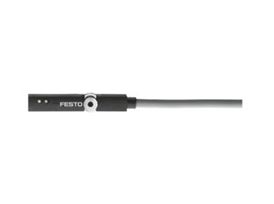Overview of FESTO (Festo) Proximity Switch SIEN - M8B - PS - K - L
FESTO (Festo), as a globally renowned supplier of automation technology, is known for the high quality, reliability, and innovation of its products. The proximity switch SIEN - M8B - PS - K - L is one of many outstanding products from Festo. This proximity switch has a wide range of applications in the field of industrial automation, where it can detect the presence or absence of objects non-contactingly, providing precise position detection and control signals for automated production processes.
From an aesthetic perspective, SIEN - M8B - PS - K - L features a compact design, with its small 8mm diameter allowing for easy installation in equipment with limited space. This compact design not only saves installation space but also facilitates the overall layout of the equipment. Additionally, its housing is made of robust and durable materials, capable of withstanding various harsh industrial environments such as high temperatures, humidity, and dust, ensuring the stability and reliability of the product over long-term use.
Operating Principle and Technical Parameters of FESTO (Festo) Proximity Switch SIEN - M8B - PS - K - L
SIEN - M8B - PS - K - L employs advanced sensing technology. When the object to be detected approaches the switch's sensing surface, it causes a change in the internal electromagnetic field of the switch, thereby triggering the switch action and outputting the corresponding signal. This non-contact detection method avoids mechanical wear, greatly extending the service life of the switch.
In terms of technical parameters, the proximity switch has excellent performance. Its detection range is typically between a few millimeters and a dozen millimeters, with specific values depending on different application scenarios and the material of the object being detected. Its response time is extremely short, allowing for rapid and accurate detection of the approach and departure of objects, ensuring the efficient operation of automated production processes. Furthermore, it has high repeatability, maintaining stable detection results over multiple detections, providing a guarantee for the consistency of the production process.
The output method of the proximity switch is PNP Normally Open, which is widely used in industrial automation and can easily connect with various control systems. At the same time, it has a wide operating voltage range, generally 10 - 30V DC, which allows it to adapt to different power environments, enhancing the product's versatility and compatibility.
Application Scenarios and Advantages of FESTO (Festo) Proximity Switch SIEN - M8B - PS - K - L
SIEN - M8B - PS - K - L is widely used in many industrial fields. On automated production lines, it can be used to detect the position of workpieces, ensuring that workpieces are processed and assembled in the correct position. For example, in the automotive manufacturing industry, it can detect the installation position of automotive parts, ensuring the accuracy and quality of assembly. In the electronic manufacturing
Proximity Switch SIEN-M8B-PS-K-L belongs to the Sensors series under FESTO company, model number SIEN-M8B-PS-K-L. To purchase or inquire about Proximity Switch SIEN-M8B-PS-K-L, you can directly contact 158 0047 0089 (Mr. He).



